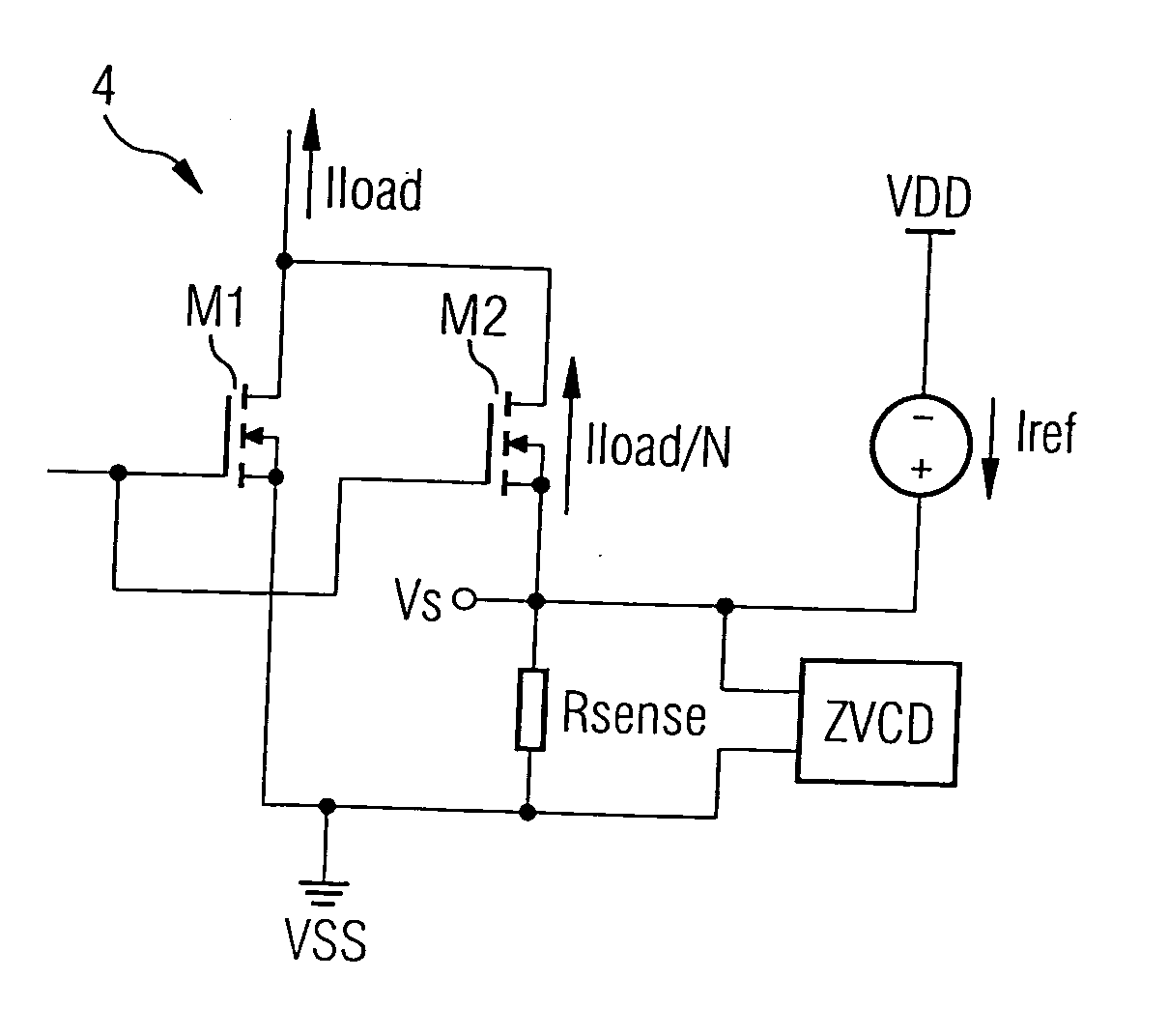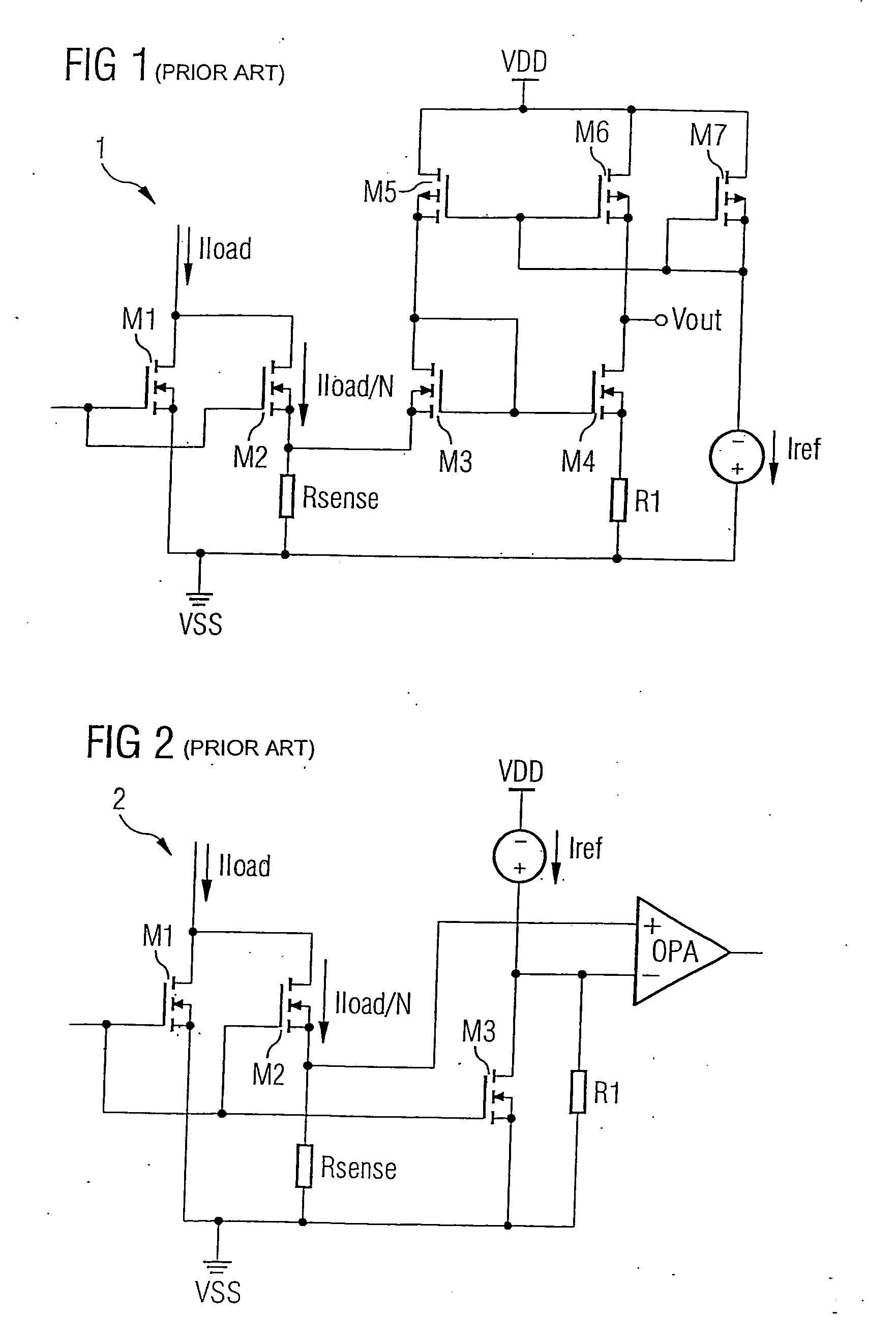Current sensing circuit
a current sensing circuit and current sensing technology, applied in the direction of resistance/reactance/impedence, pulse technique, instruments, etc., can solve the problems of inability to achieve prior art solutions, inability to find negative rails, inaccuracy of current measurement, etc., to achieve efficient sensing of current flowing through the transistor, efficient detecting load current through load
- Summary
- Abstract
- Description
- Claims
- Application Information
AI Technical Summary
Benefits of technology
Problems solved by technology
Method used
Image
Examples
first embodiment
[0034] In FIG. 4 the circuit arrangement according to the invention is designated by the reference numeral 4. In this embodiment of the circuit arrangement according to the invention, a main transistor M1 and a sensing transistor M2 are provided. Both transistors M1 and M2 are n-channel MOS transistors and are interconnected on their drain sides. Furthermore, the control terminal of the sensing transistor M2 is connected to the control terminal of the main transistor M1. The load path of the main transistor M1 is connected in series with the load, which is not shown in FIG. 4. A load current Iload flows through the load path of the main transistor M1. Since the area (or the width) of the sensing transistor M2 has a value which is a fraction 1 / N of the area (or the width) of the main transistor M1, a scaled current Iload / N flows through the load path of the sensing transistor M2. The area (or the width) of the main transistor M1 is much larger than the area (or the width) of the sens...
second embodiment
[0040] In FIG. 5 the circuit arrangement according to the invention is designated by the reference numeral 5. In contrast to the circuit arrangement 4 shown in FIG. 4, FIG. 5 shows how the inventive concept can be implemented into a high-side switch. In FIG. 5 the same elements as in FIG. 4 are provided with the same reference symbols.
[0041] In the circuit arrangement 5 the main transistor M1 and the sensing transistor M2 are p-channel MOS transistors. The control terminal of the sensing transistor M2 is connected to the control terminal of the main transistor M1. The load path of the main transistor M1 is connected in series with the load, which is not shown in FIG. 5. A load current Iload flows through the load path of the main transistor M1. Since the width (or the area) of the sensing transistor M2 has a value which is a fraction 1 / N of the width (or the area) of the main transistor M1, a scaled current Iload / N flows through the load path of the sensing transistor M2. The factor...
third embodiment
[0044] In FIG. 6 the circuit arrangement according to the invention is designated by the reference numeral 6. The circuit arrangement 6 is a buck converter comprising the circuit arrangement 5 shown in FIG. 5. As can be seen from FIG. 6, the supply potential VDDb being higher than the supply potential VDD is in this example obtained by bootstrapping the switching node.
PUM
 Login to View More
Login to View More Abstract
Description
Claims
Application Information
 Login to View More
Login to View More - R&D
- Intellectual Property
- Life Sciences
- Materials
- Tech Scout
- Unparalleled Data Quality
- Higher Quality Content
- 60% Fewer Hallucinations
Browse by: Latest US Patents, China's latest patents, Technical Efficacy Thesaurus, Application Domain, Technology Topic, Popular Technical Reports.
© 2025 PatSnap. All rights reserved.Legal|Privacy policy|Modern Slavery Act Transparency Statement|Sitemap|About US| Contact US: help@patsnap.com



